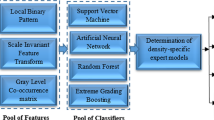Abstract
Purpose
Classification of a suspicious mass (region of interest, ROI) in a mammogram as malignant or benign may be achieved using mass shape features. An ensemble system was built for this purpose and tested.
Methods
Multiple contours were generated from a single ROI using various parameter settings of the image enhancement functions for the segmentation. For each segmented contour, the mass shape features were computed. For classification, the dataset was partitioned into four subsets based on the patient age (young/old) and the ROI size (large/small). We built an ensemble learning system consisting of four single classifiers, where each classifier is a specialist, trained specifically for one of the subsets. Those specialist classifiers are also an optimal classifier for the subset, selected from several candidate classifiers through preliminary experiment. In this scheme, the final diagnosis (malignant or benign) of an instance is the classification produced by the classifier trained for the subset to which the instance belongs.
Results
The Digital Database for Screening Mammography (DDSM) from the University of South Florida was used to test the ensemble system for classification of masses, which achieved a 72% overall accuracy. This ensemble of specialist classifiers achieved better performance than single classification (56%).
Conclusion
An ensemble classifier for mammography-detected masses may provide superior performance to any single classifier in distinguishing benign from malignant cases.
Similar content being viewed by others
References
National Cancer Institute (2010) American Cancer Society Cancer Facts & Figures 2010. http://www.cancer.org
Winchester DJ, Winchester DP, Hudis CA, Norton L (2007) Breast cancer (2nd edn). Springer, New York
Cheng HD, Shi XJ, Min R, Hu LM, Cai XP et al (2006) Approaches for automated detection and classification of masses in mammograms. Pattern Recognit. doi:10.1016/j.patcog.2005.07.006
Jiang L, Song E, Xu X, Ma G, Zhang B (2008) Automated detection of breast mass spiculation levels and evaluation of scheme performance. Acad Radiol. doi:10.1016/j.acra.2008.07.015
Kupinski MA, Giger ML (1998) Automated seeded lesion segmentation on digital mammograms. IEEE Trans Med Imag. doi:10.1109/42.730396
Mencattini A, Rabottino G, Salmeri M, Lojacono R, Colini E (2008) Breast mass segmentation in mammographic image by an effective region growing algorithm. Advanced Concepts for Intelligent Vision Systems Conference. doi:10.1007/978-3-540-88458-3_86
Xu W, Xia S, Xiao M, Duan H (2005) A model-based algorithm for mass segmentation in mammograms. Engineering in medicine and biology 27th annual conference. doi:10.1109/IEMBS.2005.1616987
Yuan Y, Giger ML, Li H, Suzuki K, Sennett C (2007) A dual-stage method for lesion segmentation on digital mammograms. Med Phys 34: 4180–4193. doi:10.1118/1.2790837
Byrd K, Zeng J, Chouikha M (2005) Performance assessment of mammography image segmentation algorithms. 34th applied imagery and pattern recognition workshop, pp 152–157
Zhang Y, Tomuro N, Furst JD, Raicu DS (2010) Image enhancement and edge-based mass segmentation in mammogram. 2010 SPIE medical imaging conference. doi:10.1117/12.844492
Zhang Y, Tomuro N, Furst JD, Raicu DS (2011) Multiple weak segmentors for strong mass segmentation in mammogram. 2011 SPIE medical imaging conference. doi:10.1117/12.877450
Domínguez1 AR, Nandi AK (2009) Toward breast cancer diagnosis based on automated segmentation of masses in mammograms. Pattern Recognit. doi:10.1016/j.patcog.2008.08.006
Delogu P, Fantacci M, Kasae P, Retico A (2007) Characterization of mammographic masses using a gradient-based segmentation algorithm and a neural classifier. Comput Biol Med. doi:10.1016/j.compbiomed.2007.01.009
Sampat MP, Markey MK, Bovik AC (2005) Computer-aided detection and diagnosis in mammography. Elsevier Academic Press, New York
Ghosh R, Ghosh M, Yearwood J (2004) A modular framework for multicategory feature selection in digital mammography. ESANN’2004 proceedings, pp 175–180. ISBN 2-930307-04-8
Zhang P, Verma B, Kumar K (2005) Neural vs. statistical classifier in conjunction with genetic algorithm based feature selection. Pattern Recognit Lett. doi:10.1016/j.patrec.2004.09.053
Opitz D, Maclin R (1999) Popular ensemble methods: an empirical study. J Artif Intell Res. doi:10.1613/jair.614
Dzeroski S, Zenko B (2004) Is combining classifiers with stacking better than selecting the best one? Mach Learn. doi:10.1023/B:MACH.0000015881.36452.6e
Breiman L (1996) Bagging predictors. Mach Learn 24: 123–140
Wolper DH (1992) Stacked generalization. Neural Netw 5: 241–259
Ting K, Witten I (1999) Issues in stacked generalization. J Artif Intell Res 10: 271–289
Freund Y, Schapire R (1996) Experiments with a new boosting algorithm. In: Proceedings of the 13th international conference on machine learning, pp 148–156
Zhang Y, Tomuro N, Furst JD, Raicu DS (2009) Using BI-RADS descriptors and ensemble learning for classifying masses in mammograms. Medical Content-based Retrieval for Clinical Decision Support (MCR-CDS). doi:10.1007/978-3-642-11769-5_7
Heath M, Bowyer K, Kopans D, Moore R, Kegelmeyer WP (2001) The digital database for screening mammography. In: Proceeding of the 5th international workshop on digital mammography, pp 212–218
Choras R (2008) Shape and texture feature extraction for retrieval mammogram in databases. Inf Tech Biomed 47: 121–128
Quinlan R (1993) C4.5: programs for machine learning. Morgan Kaufmann Publishers, San Mateo
Witten I, Frank E (2005) Data mining: practical machine learning tools and techniques (2nd edn). Morgan Kaufmann, San Francisco
Author information
Authors and Affiliations
Corresponding author
Rights and permissions
About this article
Cite this article
Zhang, Y., Tomuro, N., Furst, J. et al. Building an ensemble system for diagnosing masses in mammograms. Int J CARS 7, 323–329 (2012). https://doi.org/10.1007/s11548-011-0628-7
Received:
Accepted:
Published:
Issue Date:
DOI: https://doi.org/10.1007/s11548-011-0628-7




